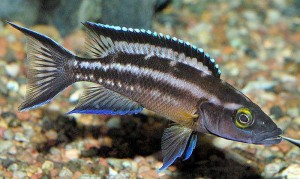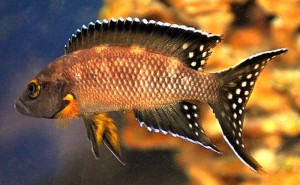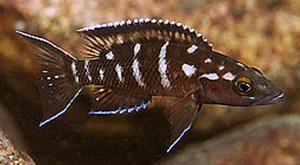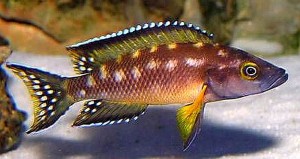The Striped Lamprologus (Neolamprologus buescheri) is a Lake Tanganyikan cichlid that inhabits areas of shoreline with rocky substrates from Tembwe II on the western coast, all around the southern part of the lake, up to Samazi on the eastern side. Several geographical morphs are available from other areas of the lake, including “gombi”, “kachese”, “kamakonde”, and “zaire”.
Striped Lamprologus are one of the most aggressive and territorial species in the aquarium hobby, and are best housed in a single species tank. Several females should be kept for each male in order to reduce harassment by the male, and only a single male should be kept in the tank unless it is extremely large. The females will set up small territories that are inside the male’s territory.
Some tropical fish keeping enthusiasts have successfully kept Striped Lamprologus with some of the other
small to medium sized Tanganyikan cichlids (like Cyprichromis) but avoid the shell dwellers. Other rock dwelling species like the Julidochromis or Altolamprologus are also possibilities, but only in large aquariums with plenty of separate territorial rock settings.
Striped Lamprologus should never be housed with mbuna or other rambunctious cichlid species or cichlids large enough to consider them part of their diet.
Neolamprologus buescheri are without a doubt the most aggressive of all the small Tanganyikan cichlids and are definitely NOT recommended for beginners.
Striped Lamprologus are cave dwellers and should be housed in at least a 55 gallon aquarium set up with plenty of stones and rocks that are formed into caves and crevices for them to hide among. The tank should have a very fine gravel or sandy substrate and if your choose, plants to provide a more aesthetic scene.
Striped Lamprologus are cave spawners and breeding them is not especially difficult however, sexing them is. Males and females look identical but if you can purchase sexed specimens, buy a single male and several females for the breeding tank. If this is not possible, purchase several juveniles and grow them together so they can pair off, but be prepared to accept losses. The dominant male in the tank will decimate the sub-dominant males until only one remains.
When a dominant male and several females are selected, place them in the breeding tank described above with a pH of 8.2 to 9.0 and a water temperature of 77 to 80 degrees F.
Each of the female fish will select a spawning cave to lay their eggs. The male will often then keep the females from leaving the immediate area of their cave. The female will then deposit their eggs on the roof of the cave where they are fertilized by the male. After spawning has occurred, the female tends to the eggs until they are hatched out and the male plays no further role in the process except to guard the territory around the cave. The fry will remain in the cave for several days and are tolerated in the vicinity of the cave until they reach about 1 1/2″ in size.
The actual act of spawning is so secretive that most often you will not know that spawning has even occurred until they fry appear at the mouth of the cave. Because of the unpredictability of the males, successful breeders will usually remove the fry as soon as they are noticed in the tank
Striped Lamprologus fry are large enough to be fed or newly hatched baby brine shrimp as soon as they are born.
Adult Striped Lamprologus are omnivorous but prefer live foods such as mosquito larvae, bloodworms, tubifex, brine shrimp, etc. They can be fussy eaters and often turn down dried flake foods or pellets. Usually frozen bloodworms, brine shrimp and the like are eagerly accepted.
Neolamprologus buescheri are not usually available at tropical fish keeping shops or online as juveniles or adults. When available they demand a modest price at any size.
Minimum Tank Size: 55 gallons
Care Level: Moderate
Temperament: Extremely aggressive
Aquarium Hardiness: Hardy
Water Conditions: 75°-82°F, 9-25°dH, pH 7.5-9.0
Max. Size: 2.8″ to 3.1″
Color Form: Gray, Black
Diet: Omnivorous
Compatibility: Single species tank
Origin: Lake Tanganyika
Family: Cichlidae
Lifespan: 5-8 years
Aquarist Experience Level: Advanced (Not recommended for the beginner)






